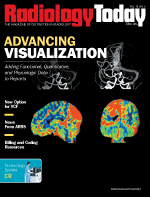 June 2014
June 2014
Patient-Centric EMR — Tearing Down Silos at MD Anderson
By David Yeager
Radiology Today
Vol. 15 No. 6 P. 6
As accountable care organizations take root and grow, the demand for medical records that aggregate clinical information from sources will grow as well. The anticipated shift from fee-for-service care to bundled or capitated reimbursement will place a premium on clinicians having ready access to patient records—including medical images—preferably in a single repository. But storing medical images alongside nonimage data requires the flexibility to share data among various clinical systems.
This is a challenge that the radiation therapy (RT) department at the University of Texas MD Anderson Cancer Center in Houston has seen up close. The RT department operates 10 CT scanners as well as numerous treatment systems with on-board CT. In addition to using diagnostic CT, they use CT, MRI, and PET data to create a digital model for treatment planning and monitoring. Peter Balter, MS, PhD, a medical physicist at MD Anderson, says patients may be scanned from once per week to twice per day during treatment. Storing all of that imaging data is one thing, but the radiation oncologists also need access to treatment plans, which the PACS does not store.
With four regional data centers sharing a PACS and a radiation oncology management system as well as patients coming to the center from other hospitals, incorporating all of the necessary data was a challenge. Adding to the data mass was the RT department’s in-house EMR system, which had been designed for communicating treatment parameters from the linear accelerators to the treatment machines but had grown to encompass patient scheduling, billing information, patient ID photos, and various miscellaneous medical images.
When it was time to buy a new PACS, Balter was faced with several constraints. The new system had to support various DICOM profiles, including RT Plan, RT Structure Set, and RT Dose. It also had to support RT Ion, which still was in development at the time, so no vendors would support it. Balter wanted the new system to have a Web user interface for general users, too, with the ability to query and transfer images, verify archives, and store non-DICOM digital objects, such as treatment plans.
Wish List
MD Anderson’s IT department wanted the system to support open standards, use the institution’s identity management system so users would only need a single sign-on, and use the institution’s service area network. In addition, the vendors Balter spoke with suggested that the system include transaction logging, tiered storage for data life cycle management, and the ability to automatically age the data off the system. There was no PACS that met all of these requirements.
Rather than focusing on new hardware and migrating to a new system, the RT department decided to use software to connect the data-generating systems that already were in place. For this task, they chose TeraMedica’s Evercore Clinical Enterprise Suite, which connects various clinical systems to the institution’s own servers and functions as a vendor-neutral archive. Starting with DICOM images, the RT department began connecting all of the DICOM-generating equipment to the archive via Evercore. They then began archiving treatment plans as non-DICOM objects.
“Now, when the patient comes back for treatment, we can go to one place, get their previous images if we need them and [access] the contours, which are the RT structure objects,” Balter says. “We also get all of our archiving from our two treatment-planning systems, which is now going through Evercore as non-DICOM objects.”
Breaking down data silos can be hard work. Making everything run smoothly required a lot of teamwork, which was in short supply at the outset. Balter says it took a little time to get the server, storage, database, and network teams working together. He recommends identifying a champion from each group to work through the connectivity problems that are bound to crop up.
The choice of IT platform also is important. Balter says the implementation group initially chose a platform based on its project manager’s familiarity with it, only to find out that it was difficult to problem solve for it. During a later project upgrade, the platform was switched to commonly used Windows and became much easier to manage.
Now that the system is in place, the RT department can eliminate backup tapes and video modules because all data are channeled to the archive. Also, users can autodelete redundant data from the treatment systems’ DICOM buffer because they have confidence that the data can be retrieved from the archive if needed. In addition, the number of staff needed to manage the archive has been reduced. Maintenance is easier, too, because the institution’s servers are upgraded on a regular schedule and are maintained by an institutional team.
Across the Enterprise
Balter says the most important change is the ability to retrieve all patient data through a single interface that can be accessed from anywhere in the facility. It also allows users to send data to any device in the facility or save it to any location.
As the need for data increases, more departments will look for ways to aggregate them, while incorporating the data into their workflow. Balter says, because RT has a more complex archive than most other departments, including radiology, if connecting data silos can work for them, it can work for anybody. He believes the entire medical system eventually will be connected.
“Right now, none of the other departments are using it, but I’ve been thinking that maybe we should make the solution available,” Balter says. “We’ve been using an in-house EMR, and we’re in the process of switching. My guess is, when we switch, many more departments will be looking for something like this.”
— David Yeager is a freelance writer and editor based in Royersford, Pennsylvania. He covers imaging IT for Radiology Today.

